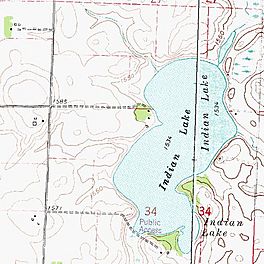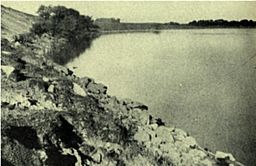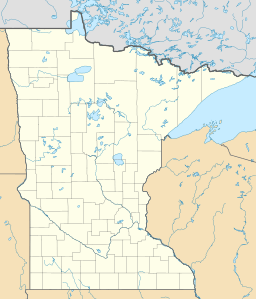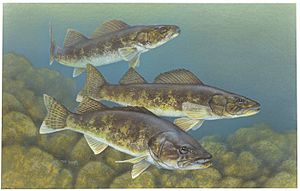Indian Lake (Nobles County, Minnesota) facts for kids
Quick facts for kids Indian Lake |
|
|---|---|

Topographic Map of Indian Lake, Minnesota
|
|

Indian Lake scene circa 1890s
|
|
| Location | Nobles County, Minnesota |
| Coordinates | 43°30′30″N 95°30′10″W / 43.50833°N 95.50278°W |
| Lake type | Glacial lake |
| Primary inflows | Several small creeks |
| Max. length | 3⁄4 mile (1.2 km) |
| Max. width | 1⁄2 mile (0.80 km) |
| Surface area | 204 acres (83 ha) |
| Average depth | 4.48 ft (1.37 m) |
| Max. depth | 6 ft (1.8 m) |
| Surface elevation | 468.17 m (1,536.0 ft) |
Indian Lake is a small lake located in Indian Lake Township, Nobles County, in the state of Minnesota. This lake is shaped like an oval and stretches about 3/4 mile from north to south. It is about 1/2 mile wide. The total area of Indian Lake is 204 acres (0.83 km2).
The lake is not very deep. Its average depth is 4.48 feet (1.37 m), and its deepest point is 6 feet (1.8 m). The lake sits at an elevation of 1,536 feet (468 m), which is about 468.17 meters above sea level.
Contents
History of Indian Lake
Indian Lake got its name because early settlers found Native Americans living along its shores when they arrived in 1869. Before that, around 1857, a group of Native Americans led by a person named Inkpaduta lived near the lake. This group was involved in a serious event known as the Spirit Lake Massacre. It is believed that the women and children of Inkpaduta's group were camped at Indian Lake when this event happened.
Inkpaduta later moved west and became friends with Sitting Bull, a famous leader of the Lakotas. Inkpaduta even took part in the Battle of the Little Bighorn, where George Armstrong Custer was defeated. Inkpaduta is thought to have passed away in Canada around 1881 or 1882.
Early Settlers and Life by the Lake
The first person to live permanently near Indian Lake was a pioneer named Issac Horton. He used to hunt elk in the Indian Lake area while renting a farm near Spirit Lake, Iowa. On May 6, 1869, he officially claimed land on the eastern side of Indian Lake.
Issac Horton built a cabin using logs from his own land and lived there for 17 years. Later, he sold his claim and bought another piece of land in Indian Lake Township, where he lived until he passed away in 1892.
Indian Lake has always remained a rural area. It is surrounded by farms, and many farm families have built their homes overlooking the lake. Nobles County also maintains a park called Hawkeye Park along the lake's shores.
Fishing in Indian Lake
Even though Indian Lake is quite shallow, it is home to many different types of fish. The most common fish found here are black crappies and white crappies.
- Black Crappies: These fish usually range from 7.4 to 12.6 inches (320 mm) long, with an average length of just over 10 inches (250 mm).
- White Crappies: These are similar in size, ranging from 8.1 to 12.6 inches and averaging 10.5 inches (270 mm).
The lake is stocked every year with young walleye fish. These walleyes typically grow to be between 12.6 and 22.5 inches (570 mm) long, with an average length of 14.7 inches (370 mm). Northern pike have only been stocked once in the last 14 years, back in February 2001. Their lengths range from 17.3 to 27.4 inches (700 mm), averaging 20.6 inches (520 mm).
In total, 12 different kinds of fish have been found in Indian Lake. These include:
- Bigmouth buffalo
- Black bullhead
- Black crappie
- Bluegill
- Common carp
- Freshwater drum
- Northern pike
- Walleye
- White crappie
- White sucker
- Yellow bullhead
- Yellow perch
Public Access to the Lake
You can get to Indian Lake from the southwestern side at Hawkeye Park. This park is managed by Nobles County. It has 5.4 acres (22,000 m2) of developed land and 35.7 undeveloped acres. The park also includes a paved boat ramp, making it easy for people to launch their boats.




